Germany has more castles than any other country in the world. While Alsace is in France, it shares the banks of the River Rhine with Germany. So, it’s only natural that there are a lot of castles here too. Towns and villages look like something out of fairy tales, while there are the rolling countryside, vineyards, and a proud and distinct identity to be found here. You can easily spend a weekend in Alsace and will want to come back for more. One thing is for sure; there is nowhere quite like Alsace!
In this post, we will show you some of the most beautiful castles in Alsace, whether atop hills, amid rolling fields, or in colourful towns.
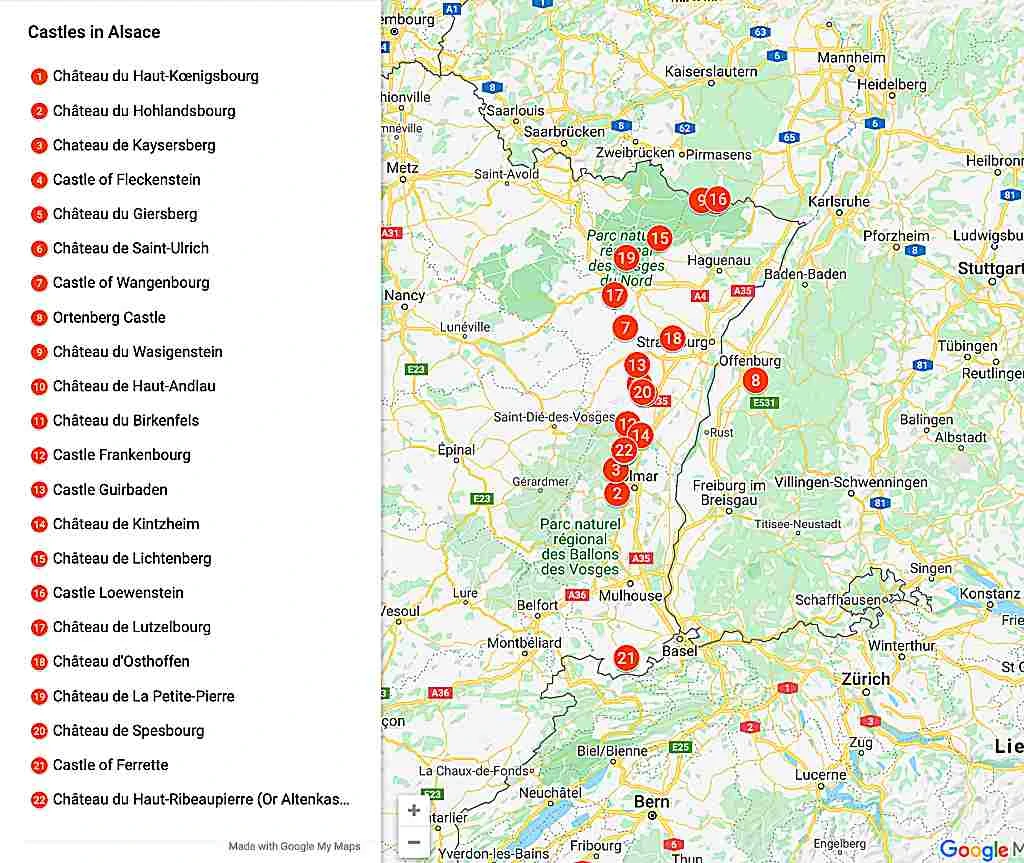
22 Castles to Visit in Alsace
1. Château du Haut-Kœnigsbourg
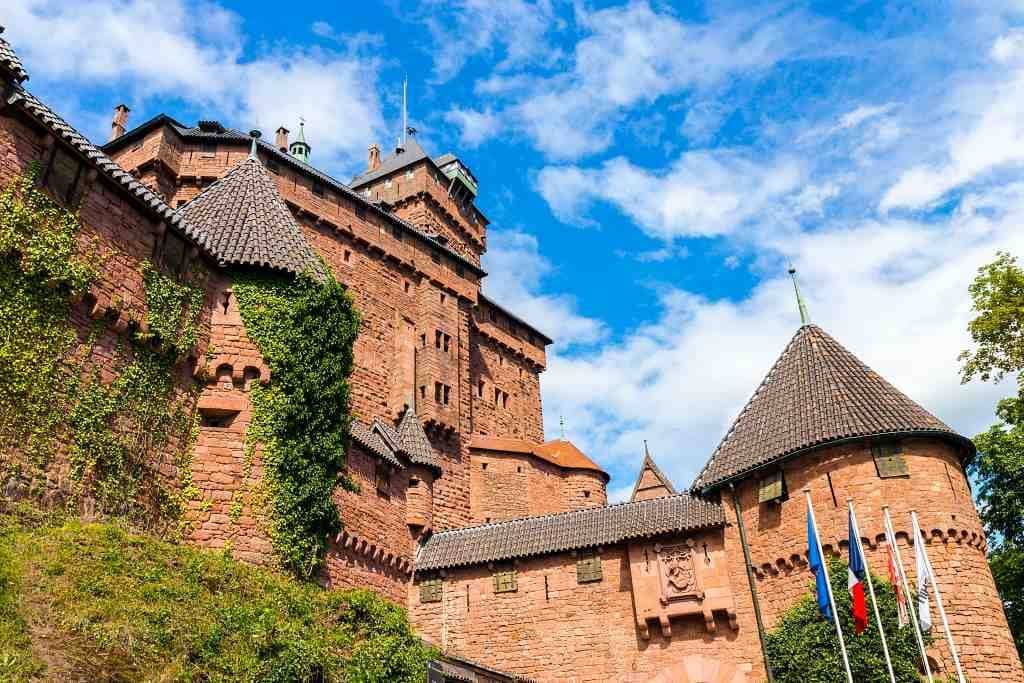
Hidden away in the Vosges Mountains is the stunning Medieval Château du Haut-Kœnigsbourg. The only medieval castle in the region that has been fully restored, it sits at a height of around 800 metres, providing sublime views of the surrounding Alsatian countryside.
It has seen countless battles and conflicts, before being restored by German Emperor Kaiser Wilhelm at the beginning of the 20th century. The castle is an easy day trip from Strasbourg.
Where: Orschwiller
When: 12th century
Open for Visit: Yes. Check here for more information.
2. Chateau du Hohlandsbourg
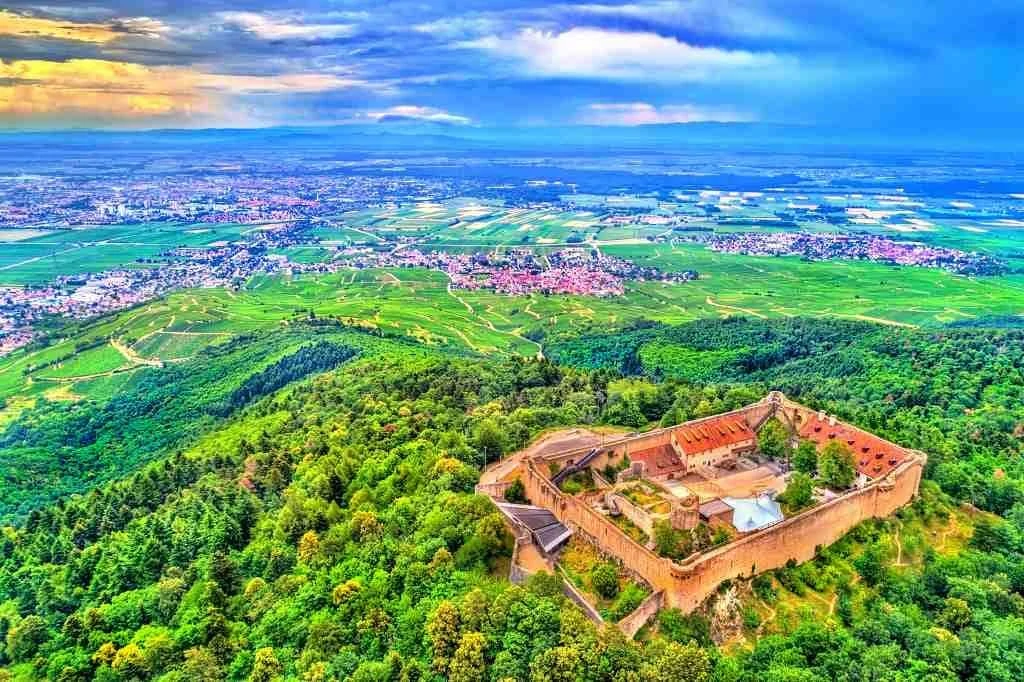
Once a medieval fortress, the now ruined Château du Hohlandsbourg was the seat of the Lords of Habsburg. It overlooks the Alsace Plains, the Black Forest, and the mountain border into Lorraine from a height of 620 metres.
You can even see the spires of Strasbourg Cathedral on a clear day! The castle has been on show from the 19th century to now, and it’s open to visitors who can enjoy one of its themed historical events. The nearest large town to Château du Hohlandsbourg is Colmar.
Where: Wintezenheim
When: 13th century
Open for Visit: Yes. Check here for more information.
3. Chateau de Kaysersberg
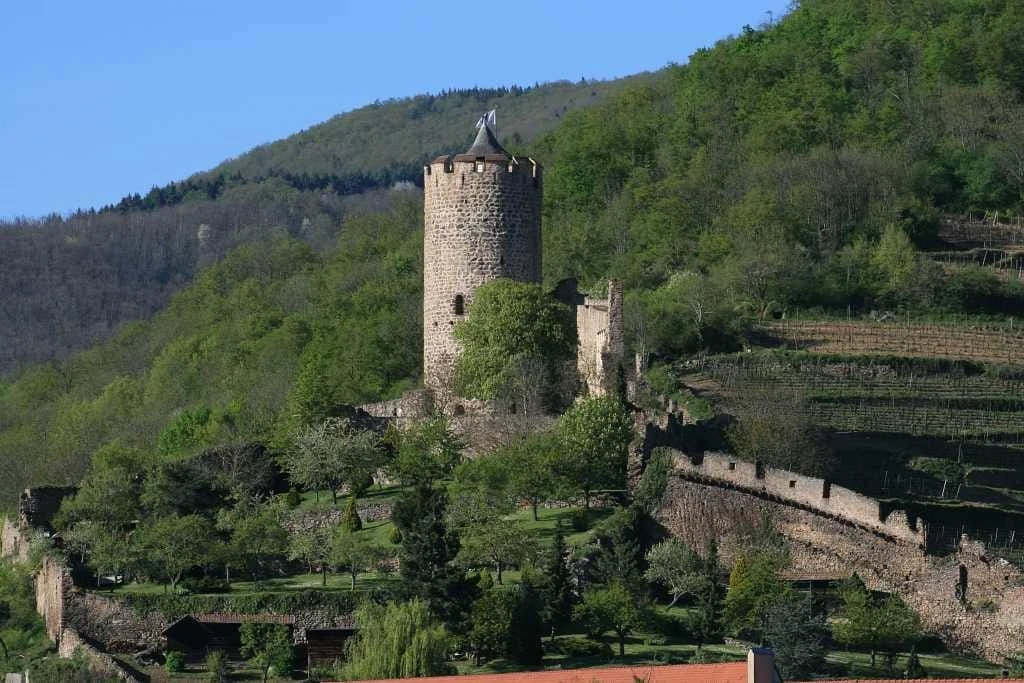
Also known as Château de Schlossberg, this ruined castle stands over the town of Kaysersberg – which means Emperor’s Mountain in German. It was built in a strategic role to close off a route between the Vosges Mountains and Lorraine.
The imperial castle consists of one of the oldest circular keeps in Alsace and a manor house. Kaysersberg castle has been listed by the French Ministry of Culture as a Monument Historique since 1841. You can explore the still-standing keep and Gothic art windows of the manor house.
Where: Kaysersberg
When: 13th century
Open for Visit: Yes. Check here for more information.
4. Chateau Fort de Fleckenstein

Located high on a sandstone ridge, Château Fort de Fleckenstein was thought to be impregnable, but it didn’t quite work out that way when it fell from the hands of the Fleckenstein family into those of Louis XIV’s soldiers.
It is in the Regional Nature Park of the Northern Vosges Mountains, so it’s a beautiful place to visit as part of a day out in the countryside. Although it is mostly a ruin, more than 100,000 people visit each year.
Where: Lembach
When: 12th century
Open for Visit: Yes. Check here for more information.
5. Chateau Girsberg
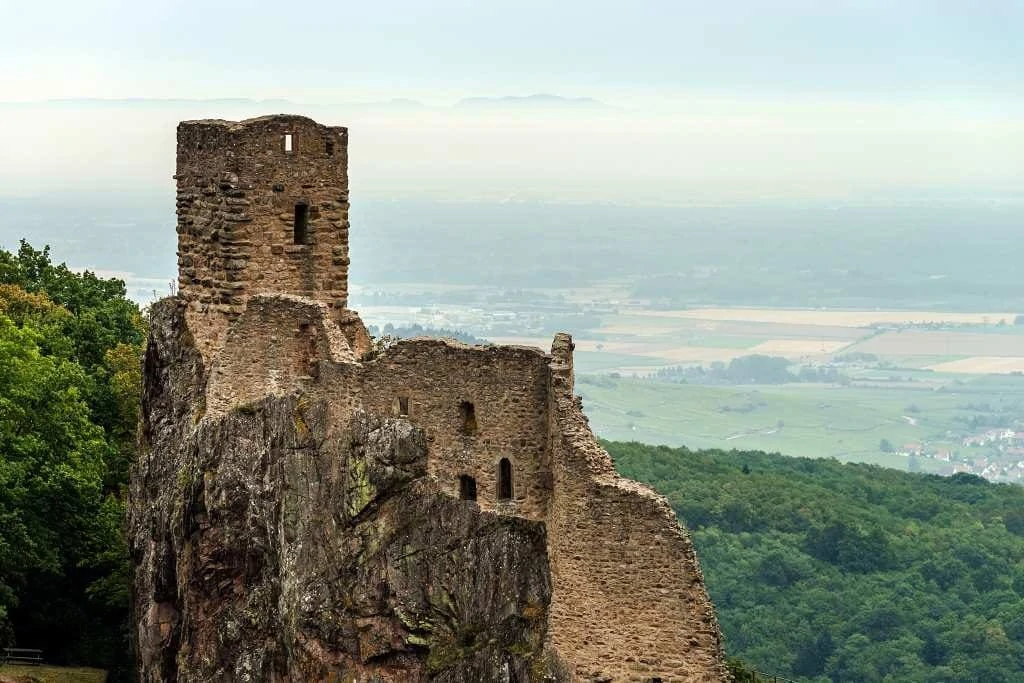
Château du Girsberg, formerly known as Petit-Ribeaupierre, is one of three Ribeauvillé castles along with St. Ulrich Castle and Haut-Ribeaupierre Castle. One is opposite, and the other is further up the mountain. They were built during the first half of the 13th century, with Girsberg providing housing quarters for the Ribeaupierre family.
The remains that can still be seen include a pentagon-shaped keep, an inner court, and a corps de logis (the principal block of a large mansion). Since the castle is a ruin, there’s no entry fee. In theory, you can visit whenever you like.
Where: Ribeauvillé
When: 13th century
Open for Visit: Yes
6. Chateau Saint-Ulrich
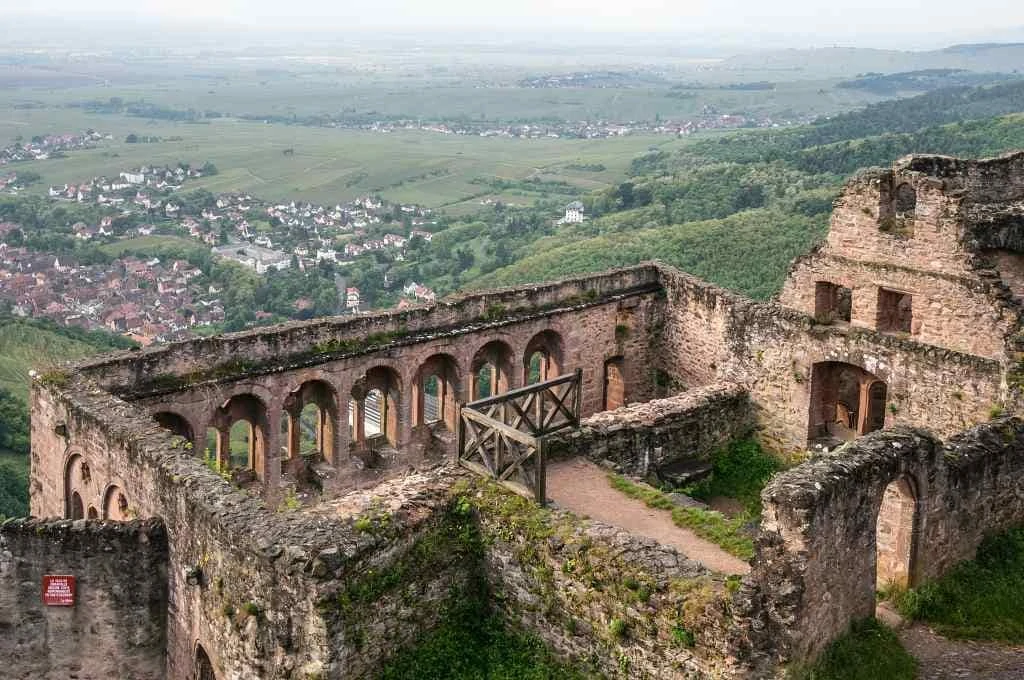
Another of the three castles overlooking Ribeauvillé, Château Saint-Ulrich was used to control the strategic route between the Alsatian Plain and the High Valley of Lièpvre. It was the home of the lords of Ribeaupierre until being abandoned in the 16th century.
The castle is named after the chapel found on the site, which is dedicated to Saint Ulrich of Augsburg. At 528 metres, it’s the second-highest of the three castles in the town and gives an impressive view of the surrounding Alsatian countryside.
Where: Ribeauvillé
When: 11th century
Open for Visit: Yes
7. Chateau du Wangenbourg
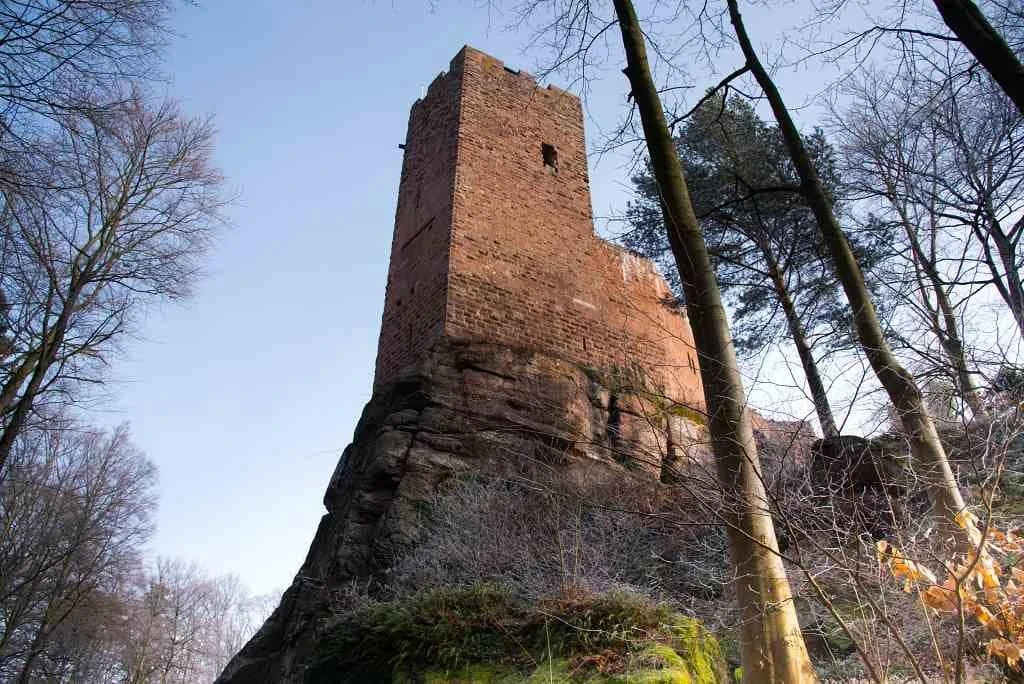
This fortified medieval castle dates back to the 13th century and can be found in the middle of one of the largest forests in the Vosges region. Although the castle is a ruin, there’s still plenty here to see, including a renaissance chimney, four-storey dungeon, and a tower.
You can climb the said tower in the summer months; the panoramic view from the top is breathtaking. Restorations on the ruined castle began in 1931, and a footbridge has replaced the original drawbridge.
Where: Wangenbourg-Engenthal
When: 13th century
Open for Visit: Yes, check here for more information.
8. Ortenbourg Castle
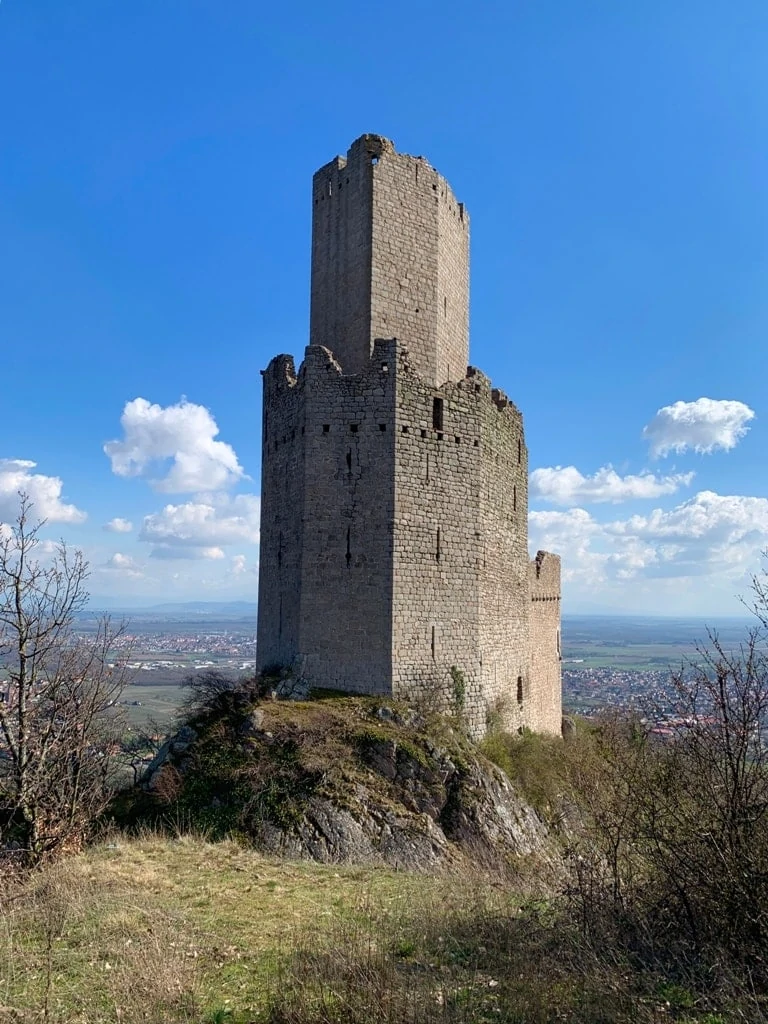
One of the most beautiful ruined castles in Alsace, it is hard to say whether it is Château de l’Ortenbourg or its surroundings that are more impressive. At 443 metres above sea level, it gives incredible views across the Valley and the Alsace Plain.
The castle was built in 1260 and sieged in 1293 before it became a den for brigand knights in the 15th century. Later in its chequered history, the Swedes burned it down in 1633. Château de l’Ortenbourg is about an hour on foot from the nearby town of Scherwiller, so it’s a good idea to bring walking boots, a picnic, and plenty of water for the journey.
Where: Scherwiller
When: 13th century
Open for Visit: Yes
9. Chateau du Wasigenstein
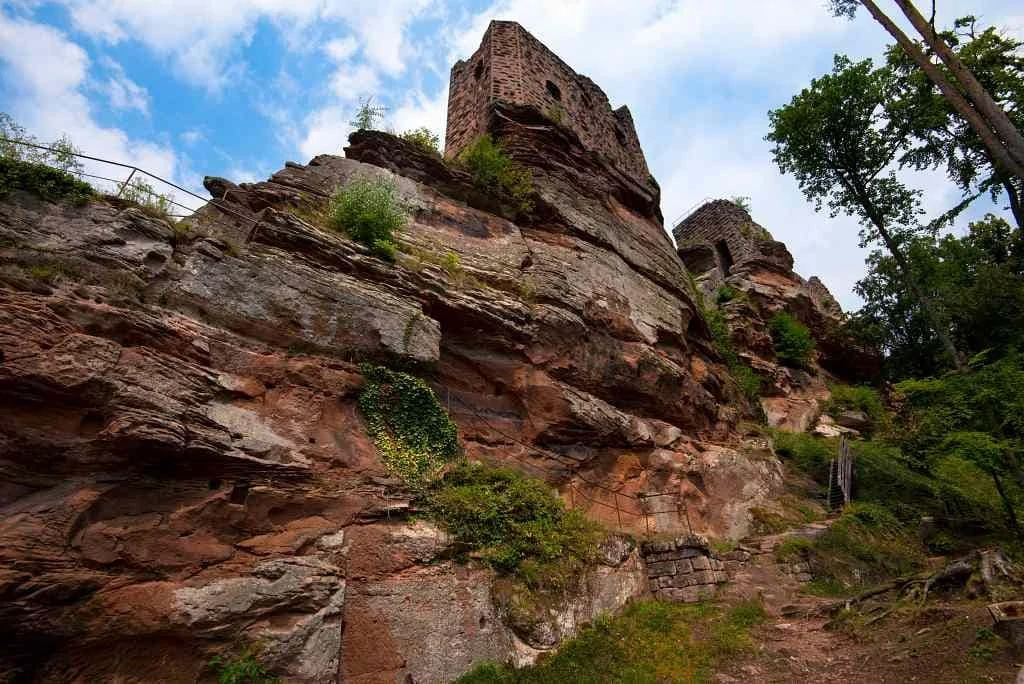
Many of the castles in Alsace are on hiking routes and give a great opportunity to get out into the countryside and see the stunning surroundings of this region. Château du Wasigenstein is no different. It’s actually two castles which lie next to each other from the 10th and 13th centuries that were built into a double fortification.
The older castle was first known as it was the centre of Waltharius, the German legend. It’s separated from the other by a rift fault. From Wasigenstein, there are views over the Langenbach valley towards Obersteinbach.
Where: Niedersteinbach
When: 10th century/13th century
Open for Visit: Yes, check here for more information.
10. Chateau d’Andlau
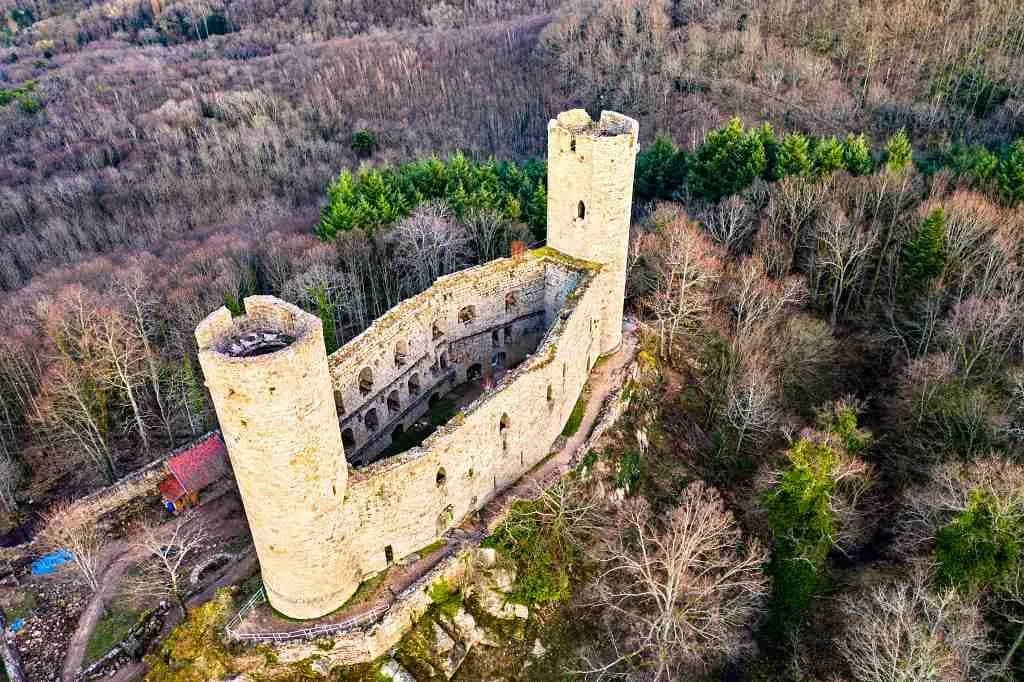
This is an unusual castle in Alsace because it has two towers instead of a single tower and a donjon. It is also built from hard granite rather than soft sandstone. It was constructed in the 13th century, dominating the valleys of Andlau and Kirneck.
When Alsace became part of France in 1678, the castle was pillaged by troops but continued to belong to the counts of Andlau until the French Revolution. The castle is maintained by a group of volunteers and still hosts events such as art shows, sound and light displays, and some other events.
Where: Andlau
When: 13th century
Open for Visit: Yes. Check here for more information.
11. Château du Birkenfels
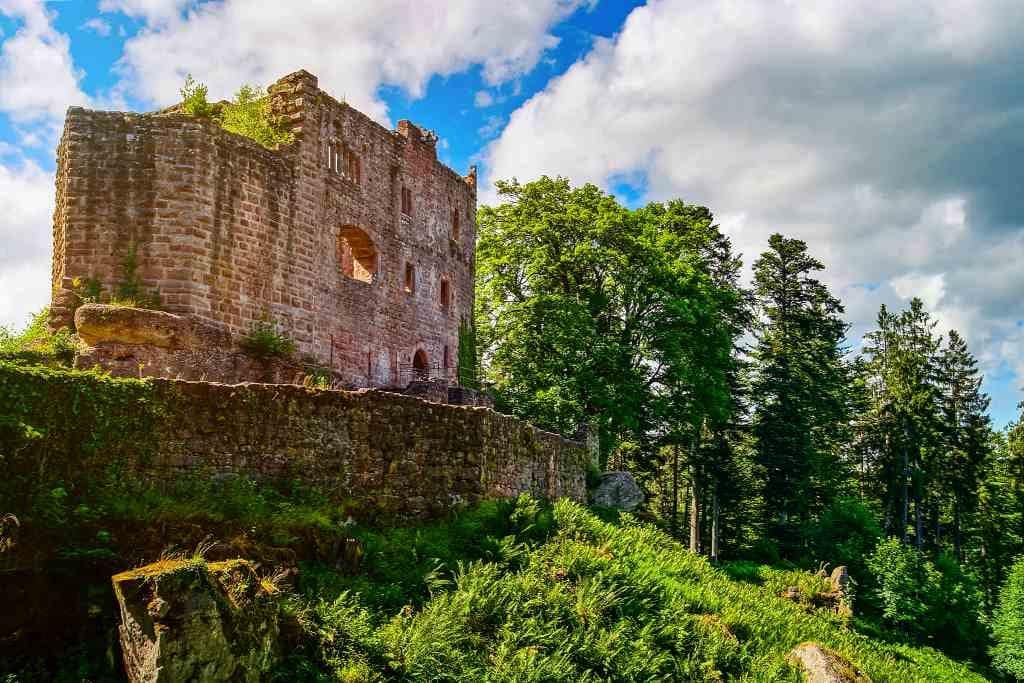
Built in 1260, Château du Birkenfels is a small castle with an unfinished pentagonal keep. It stands at 675 metres above sea level and is surrounded by the Obernai Forest.
It was built in the 13th century, only to be burned down in the 14th, then restored again in the 15th. After the Thirty Years’ War, it was taken over by the town of Obernai. Nowadays, the castle is in a poor state – but the remains are still an exciting discovery as part of a hike through the Obernai Forest.
Where: Ottrott
When: 13th century
Open for Visit: Yes, check here for more information.
12. Château du Frankenbourg

Sitting at the top of the Schlossberg Mountain, Château du Frankenbourg is a mysterious ruin which you can reach on foot from the villages of Neubois and La Vancelle. Not much is known about the castle, but it is thought that Clovis, the King of the Francs, built a castle here originally in the 5th century on his conquest of Alsace.
Some of the walls on the mountain which lead up to the castle date back to the 4th century BC, while Roman coins have been found here too. From Château du Frankenbourg, there are excellent views of the Alsace Plain and the better maintained Château du Haut-Kœnigsbourg.
Where: Neubois
When: 12th century
Open for Visit: Yes. Check here for more information.
13. Château de Guirbaden
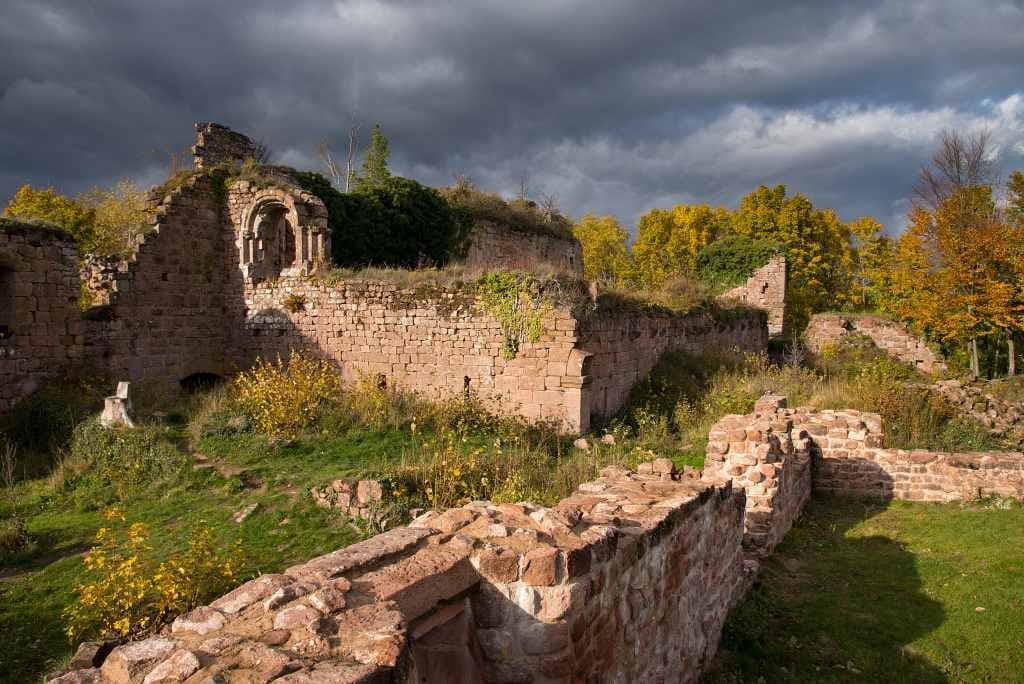
Despite its ruined status, the Château de Guirbaden covers the largest area of any castle in Alsace. It lies in the Guirbaden forest near the village of Mollkirch. Evidence shows that it was built between the 10th and 12th centuries when Alsace was part of the Holy Roman Empire.
The castle has seen many attacks, destructions, and reconstructions over the years. Now, all that remains are the main dwelling, keep some walls, and the chapel of St. Valentine. You can just walk up to the castle if you’d like to visit, but if you want to know more, guided tours are available on request.
Where: Mollkirch
When: 11th century
Open for Visit: Yes. Check here for more information.
14. Château de Kintzheim
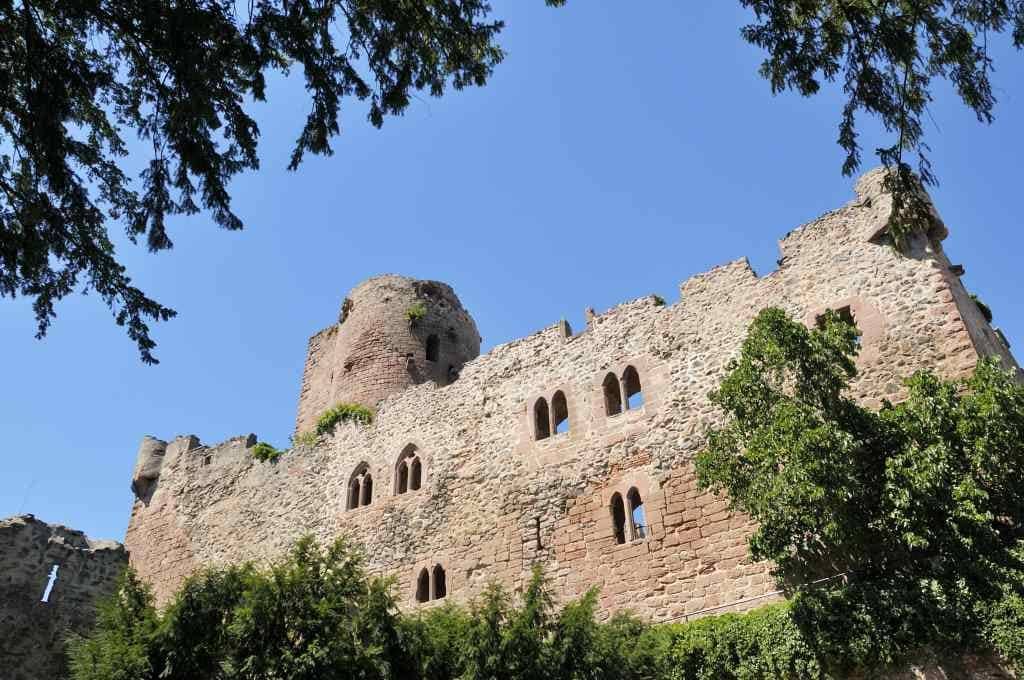
Another castle near Château du Haut-Kœnigsbourg, Kintzheim dates back to the 13th century. A keep, living quarter, and chapel are just some of the aspects remaining of this castle.
The castle has been restored and now houses an important and interesting attraction – The Bird of Prey Sanctuary. So, as well as exploring a centuries-old castle, you’ll be able to see the world’s largest birds of prey in free-flight demonstrations. Having such imposing birds at this location makes for a unique and special experience.
Where: Kintzheim
When: 13th century
Open for Visit: Yes. Check here for more information.
15. Château de Lichtenberg

Château de Lichtenberg stands and protects the village of the same name below it. The castle has a fascinating history, but even more alluring are its legends. It was said to be built on the hill where a young shepherd advised a knight he could build his castle after crossing many rivers and forests.
Another legend tells the tale of two brothers who tried to kill each other – through starvation and thirst respectively – as punishment for falling in love with the same girl.
Where: Lichtenberg
When: 13th century
Open for Visit: Yes. Check here for more information.
16. Château de Lœwenstein
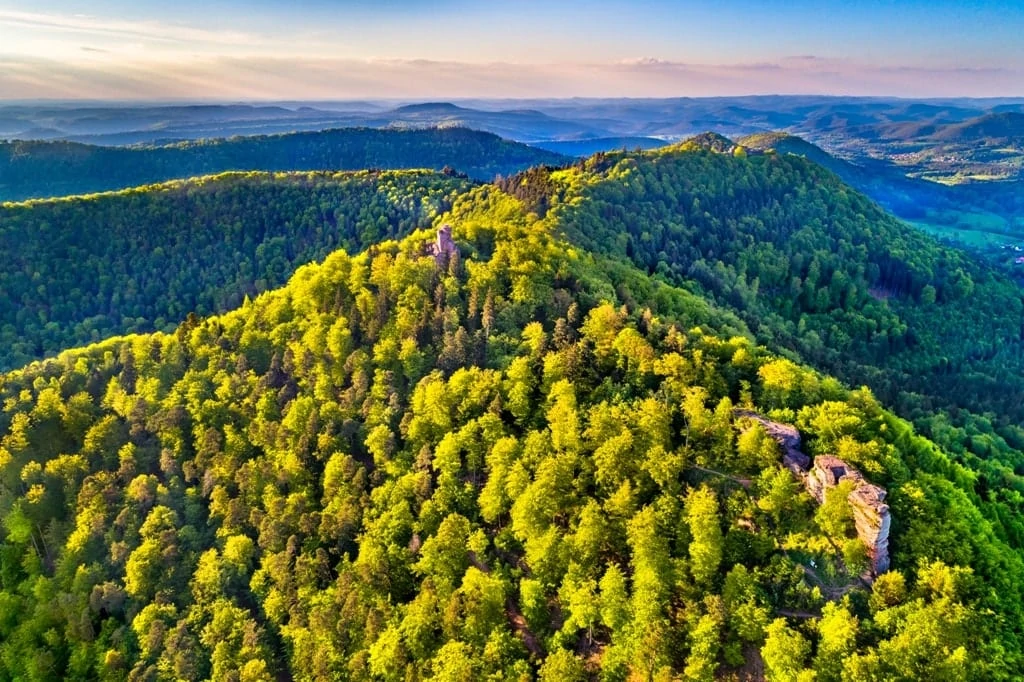
There isn’t a whole lot of Château de Lowenstein left, but it is worth a visit if you’re hiking on Schlossberg Mountain. Lœwenstein Castle is near Hohenburg, another ruined castle, and built on a gorge that is separated by two rocks.
The castle dates back to the 12th century and was destroyed only two centuries later in 1387. Before that, it had been a fief of the Holy Roman Empire and a lair of brigands. Both castles in Wingen are less than one kilometre from the French-German border.
Where: Wingen
When: 12th century
Open for Visit: Yes
17. Chateau de Lutzelbourg
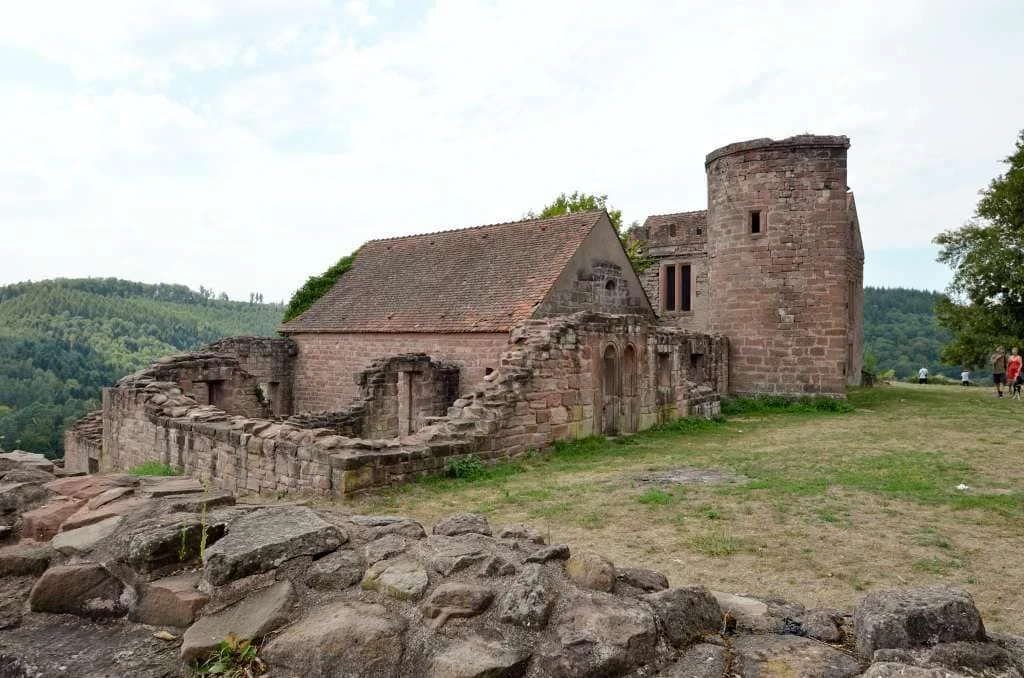
There is evidence that Château de Lutzelbourg was a fortress since around the 10th century as a part of the Abbey of Marmoutier. However, it was not until the 12th century that it was seized and Pierre de Falkenstein took the title of Lord of Lutzelbourg.
Several co-lords reigned there before it became a den for brigands. The castle was ruined in 1523 and stood as such for almost 400 years. It was restored by a doctor, who built a Neo-Romanesque house. The castle is now open to the public.
Where: Lutzelbourg
When: 11th century
Open for Visit: Yes, check here for more information.
18. Chateau d’Osthoffen
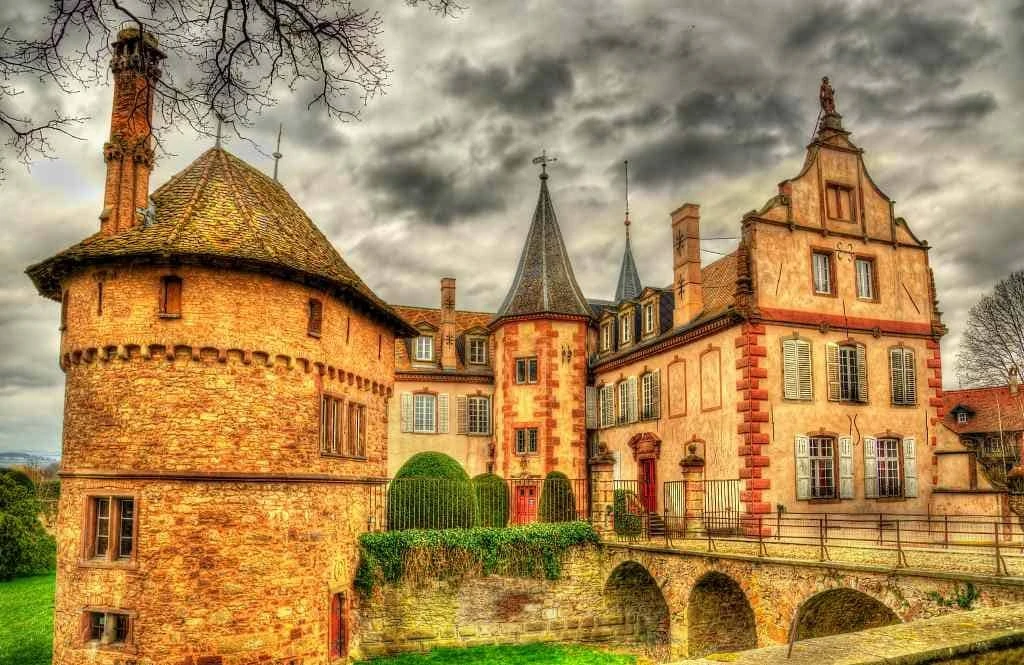
Unlike many of the other castles on this list, Château d’Osthoffen is a bed and breakfast style hotel, meaning not only can you visit, but you can actually stay the night in this magical castle. It has been owned by the same family for more than 200 years.
The castle dates all the way back to the Roman Empire, but after the 12th-century structure was largely destroyed in the French Revolution, you can see the 18th-century reconstruction. It’s a popular place to get married and is just 16km from Strasbourg.
Where: Osthoffen
When: 12th/13th century
Open for Visit: Yes, check here for more information.
19. Chateau de La Petite-Pierre
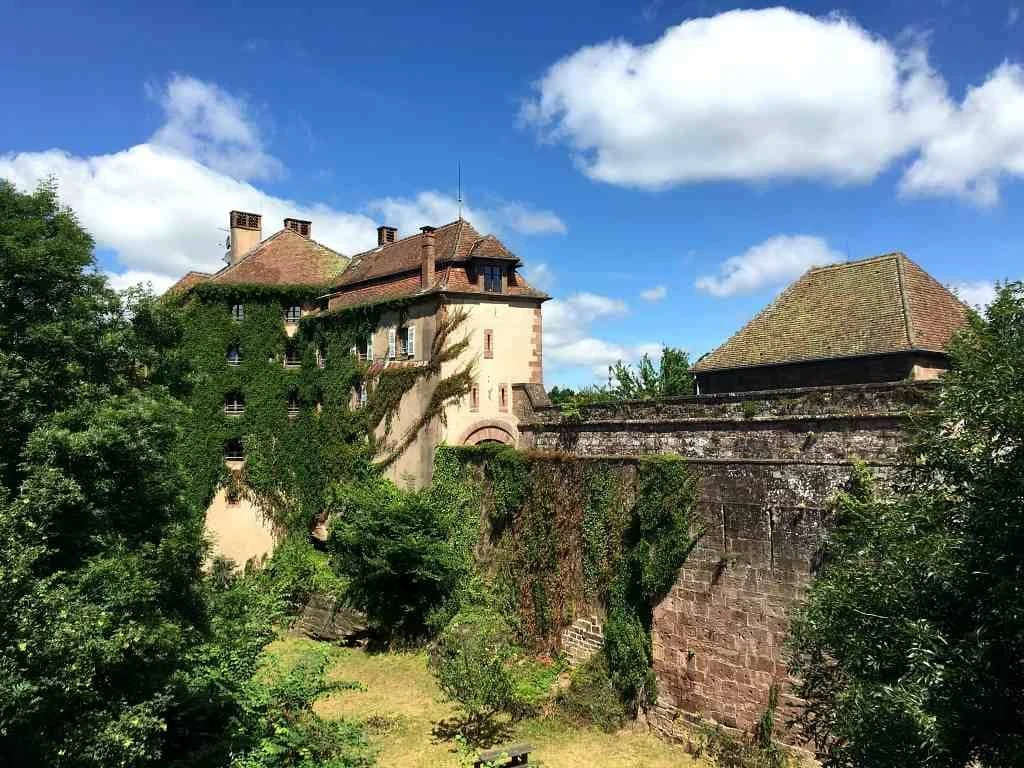
Overlooking the Northern Vosges Regional Nature Park, Château de la Petite-Pierre is where you can discover the natural beauty of Alsace and a castle at the same time. Its location means that it could strategically control the passage between the regions of Alsace and Lorraine.
The 13th-century castle’s fortifications were modernised in 1684 by Vauban. Inside the castle, there is a permanent exhibition on the history of the castle and surrounding area, called “The Adventure of Vosges du Nord”.
Where: La Petite-Pierre
When: 13th century
Open for Visit: Yes, check here for more information.
20. Chateau de Spesbourg
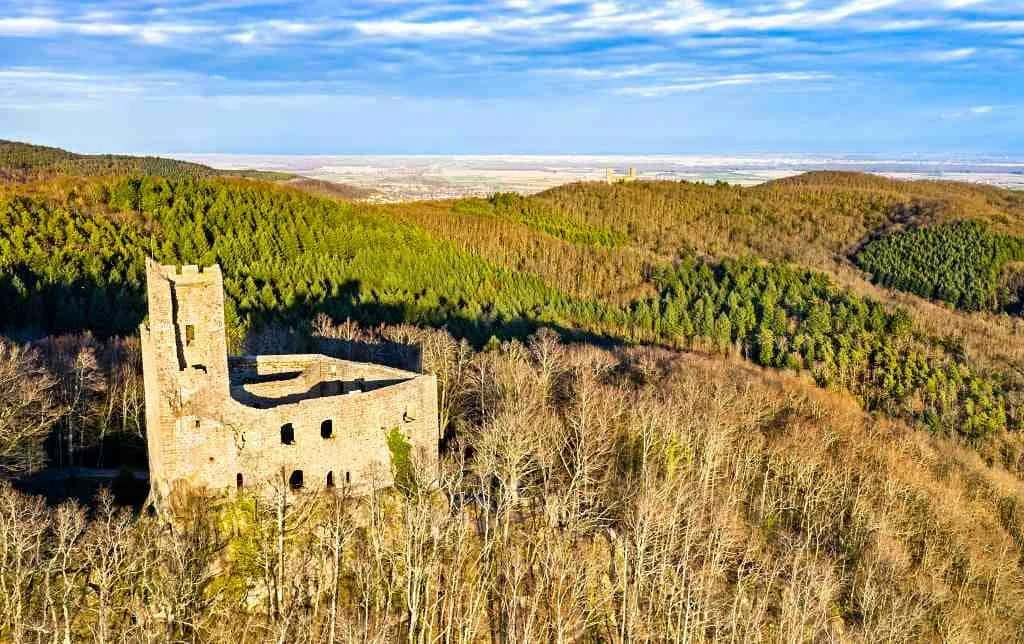
Another ruined castle in the Andlau Valley, Château de Spesbourg dates back to the 13th century. It was set alight by angry locals after one of the lords seduced a girl from a nearby village in the 16th century, before falling into ruin after the 30 Years’ War.
It’s possible to see Château d’Andlau (mentioned earlier) from Château de Spesbourg as the two castles are just two kilometres apart. Château de Spesbourg’s ruins are managed by a small group of volunteers who run festive and cultural events at the castle.
Where: Andlau
When: 13th century
Open for Visit: Yes, check here for more information.
21. Chateau de Ferrette

Château de Ferrette is one of the oldest castles in Alsace, with its first mention as far back as the year 1105AD. The castle passed down seven counts of the Ferrette Family.
Upon the death of the last count, it was passed to the House of Austria and the Habsburg Empire in 1324. It is made up of two castles – an upper part and a lower. In the lower part, you can see several half towers which were equipped with cannons.
Where: Ferrette
When: 11th/12th century
Open for Visit: Yes
22. Chateau du Haut-Ribeaupierre

Also known as Altenkastel, Château du Haut-Ribeaupierre is the highest of the three castles on the hill by Ribeauvillé, at 642 metres. It was built in the middle of the 13th century during the period known as the Great Interregnum.
It served as a watchtower for both invasions and forest fires in Alsace. The highest point of the castle is an imposing circular keep with incredible views of the surrounding mountains and Alsatian Plain.
Where: Ribeauvillé
When: 13th century
Open for Visit: Yes, check here for more information.
